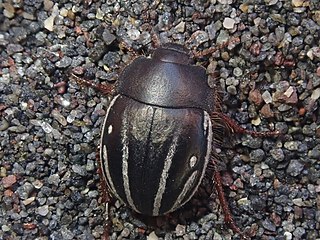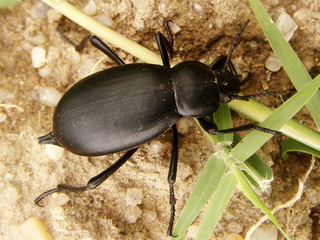
Eleodes is a genus of darkling beetles, in the family Tenebrionidae. They are endemic to western North America ranging from southern Canada to central Mexico with many species found along the Mexico-United States border. Some species have been introduced to Colombia. The name pinacate is Mexican Spanish, derived from the Nahuatl (Aztec) name for the insect, pinacatl, which translates as "black beetle."

Tenebrioninae is the largest subfamily of the darkling beetles (Tenebrionidae), containing flour beetles, among others. Tenebrioninae contains more than 20 tribes.

The Sepidiini is a tribe of ground-dwelling darkling beetles (Tenebrionidae), that occurs across Africa, the Mediterranean Basin, the Arabian Peninsula and Mesopotamia. It is composed of many hundreds of species. The larvae of some species are known to damage crops.

Eulabini is a tribe of darkling beetles in the family Tenebrionidae. There are at least three genera in Eulabini, found in North America.

Lagriinae is a subfamily of long-jointed beetles in the family Tenebrionidae. There are more than 270 genera in Lagriinae, grouped into 11 tribes.

Coelocnemis is a genus of darkling beetles in the family Tenebrionidae. There are about seven described species in Coelocnemis, found mainly in western Canada, western United States, and Mexico.

Coniontini is a tribe of darkling beetles in the subfamily Pimeliinae of the family Tenebrionidae. There are at least 4 genera in Coniontini, found in North America.

Edrotini is a tribe of darkling beetles in the subfamily Pimeliinae of the family Tenebrionidae. There are more than 50 genera in Edrotini, found primarily in North America and the Neotropics.

Praociini is a tribe of darkling beetles in the subfamily Pimeliinae of the family Tenebrionidae. There are about 15 genera in Praociini, found in the Neotropics.

Tentyriini is a tribe of darkling beetles in the subfamily Pimeliinae of the family Tenebrionidae. There are more than 90 genera in Tentyriini.
Thinobatini is a tribe of darkling beetles in the subfamily Pimeliinae of the family Tenebrionidae. There are at least two genera in Thinobatini, found in the Neotropics.
Boromorphus is a genus of darkling beetles in the family Tenebrionidae. There are at least four described species in Boromorphus, found in the Palearctic.
Cnemodinus is a genus of darkling beetles in the family Tenebrionidae. There are at least three described species in Cnemodinus. It is the only genus in the monotypic tribe Cnemodinini.
Idisia is a genus of darkling beetles in the family Tenebrionidae. Idisia has at least one described species, I. ornata, found in the Palearctic.
Phrynocarenum is a genus of darkling beetles in the family Tenebrionidae, found in the Neotropics.

Zophosis, known generally as frantic surface beetles is a genus of darkling beetles in the family Tenebrionidae. They are found in the Palearctic, tropical Africa, and Indomalaya.
Apocryphini is a tribe of darkling beetles in the family Tenebrionidae. There are at least four genera in Apocryphini.

Metaclisa is a genus of darkling beetles in the family Tenebrionidae, the sole genus of the tribe Metaclisini. There are at least four described species in Metaclisa, found in North America, the Neotropics, the Palearctic, and Indomalaya.

Amphidorini is a tribe of darkling beetles in the family Tenebrionidae. There are about 7 genera in Amphidorini.

Blaptini is a tribe of darkling beetles in the family Tenebrionidae. There are more than 30 genera recognised in the tribe Blaptini.













